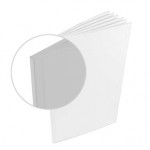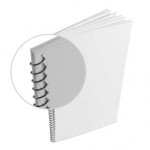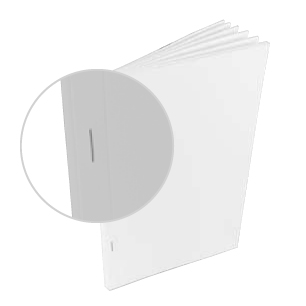Binding Methods
What is Perfect Binding?
Perfect Binding
The spine or the book is cut and roughened, adhesive is applied to the rough edges and a cover is glued firmly in place. Bleeds and crossovers are also handled differently on perfect bound books.
- Versitile
- Overall look and visual appeal
- Printable spine
- Longevity
- Ability to creatively interleaf pages
Limitations
- Doesn’t lay flat. Not suggested for applications in which hands-free reading isimportant [e.g. cookbooks, technical guides, directories or instruction manuals].
- Minimum thickness of 1⁄8″ inch needed if spine is printed or1⁄16inch if spine isn’t printed.
THE PROCESS
- Folded signatures or single leaves are gathered into a stack.
- The spine side of the stack is milled to remove the folded edges, and roughened toexpose the paper fibers. The edge of each page is left exposed.
- Hot melt adhesive is applied along the spine edge of the book. The glue does notpenetrate; it flows around the exposed fibers.
- The cover is applied to the spine while the glue is hot. It is then pressed onto thespine, and wrapped around the book block.
- Hot melt dries in 2 to 25 seconds.
- The book is run through a three knife trimmer to trim the face, the head and the foot.
What is Spiral Binding?
Spiral Stitching
To bind using a spiral of continuous wire or plastic looped through punched holes.
- Versatile & widely available
- Almost any material can be punched and bound, including paper, plastic and laminates.
- Lays flat.
- Ability to creatively interleaf pages.
- Finished piece folds over 360 degrees [useful for technical and reference applications].
- Well suited for short runs.
- Can accommodate grain short and most paper weights.
Limitations
- Not as sturdy as double loop wire.
- If the wire is crushed, it will not return to its original shape.
- Pages will jog when open and pages will step up when turned. Crossover designs willnot align.
- Wire ends are left unfinished; may snag or pull.
THE PROCESS
- Holes are drilled or punched.
- Continuous spiral wire is fed into the holes sequentially.
- Wire is crimped on both ends to prevent unravelling.
What is Side Stitch Binding?
Stapling the signatures together on the side rather than the fold.
Advantages
- Versitile & widely available
- Almost any material can be punched and bound, including paper, plastic and laminates.
- Lays flat.
- Ability to creatively interleaf pages.
- Finished piece folds over 360 degrees [useful for technical and reference applications].
- Well suited for short runs.
- Can accommodate grain short and most paper weights.
Limitations
- Not as sturdy as double loop wire.
- If the wire is crushed, it will not return to its original shape.
- Pages will jog when open and pages will step up when turned. Crossover designs willnot align.
- Wire ends are left unfinished; may snag or pull.
THE PROCESS
- Loose pages are collated and assembled into a stack.
- The loose pages are stitched or stapled parallel to the spine.
- When binding signatures, the head, foot and face of the book are trimmed.


